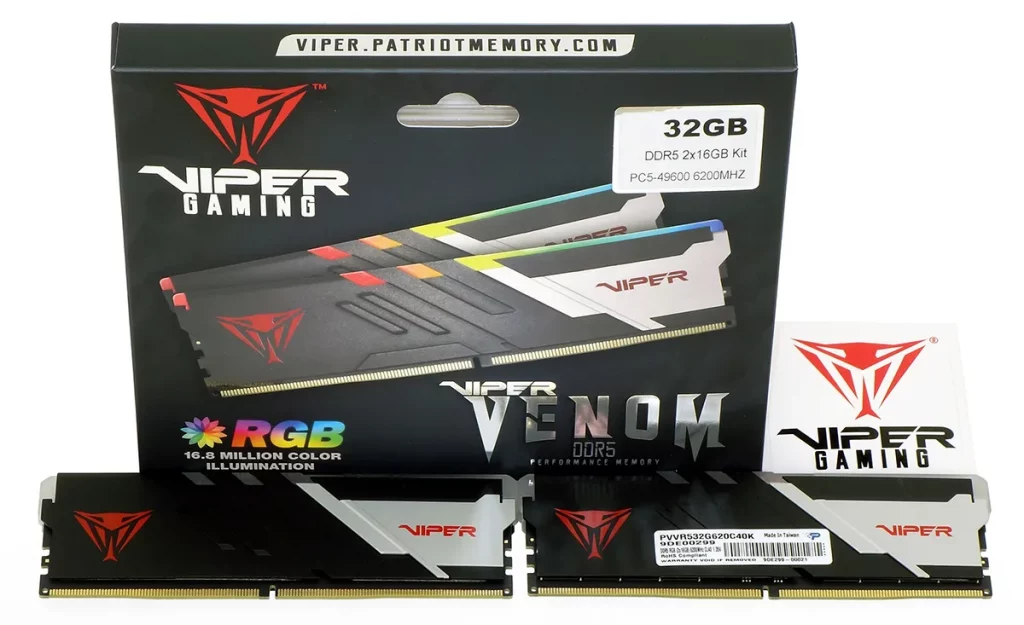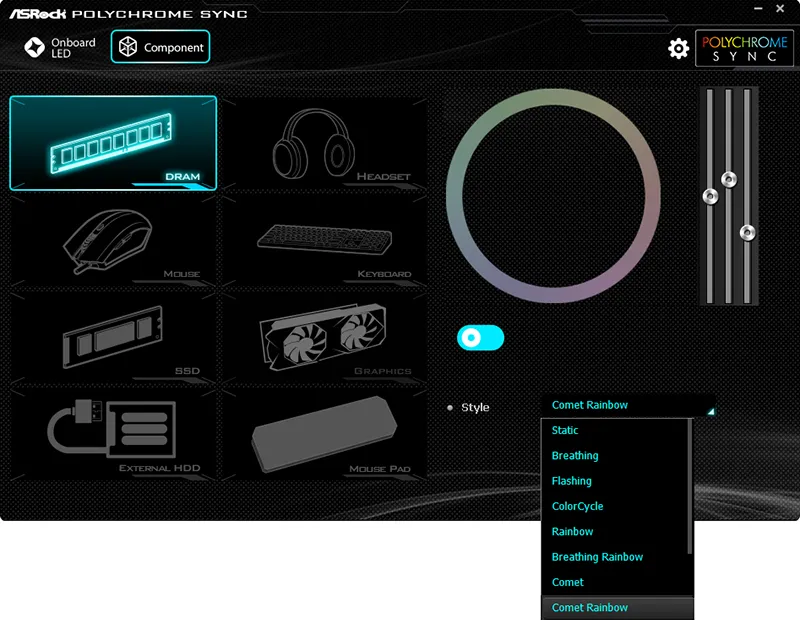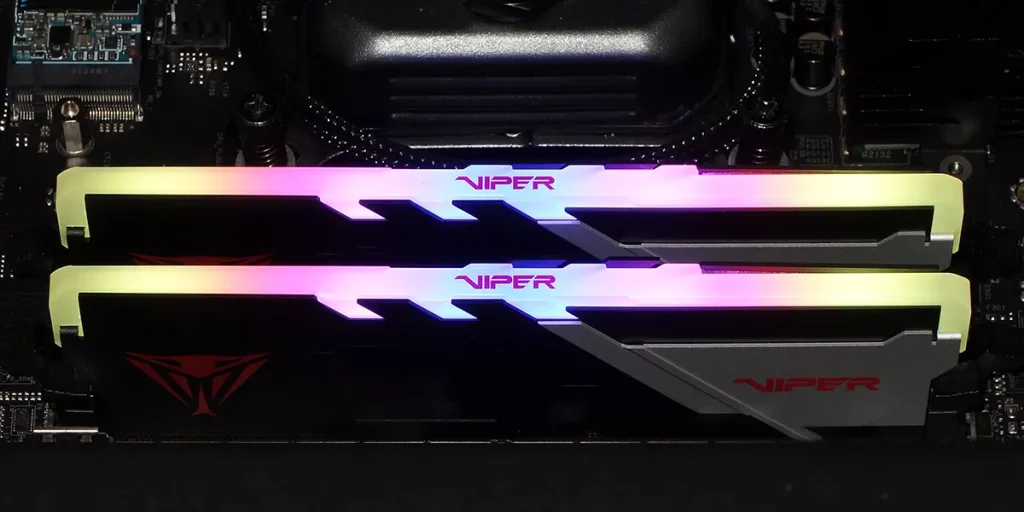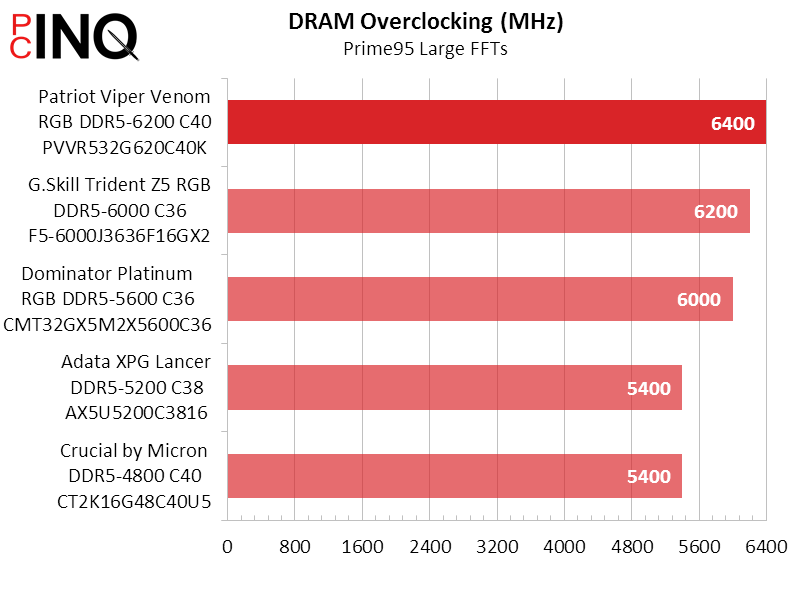Patriot Viper Venom RGB DDR5-6200 Review
Insiders told us a year ago to expect DDR5 data rates from 4800 to 6400 MHz to be common, with limited production “extreme” parts going even faster. It’s nice to see production following that plan despite the big production and distribution hiccup that had us temporarily considering alternatives only a few months back. The progression from “nobody can get parts” to “everyone is getting better parts” has brought us a continuous stream of faster components, as Patriot presents today’s Viper Venom RGB DDR5-6200.

Get it at Amazon

(click for availability)
Other than having a larger sticker than G.Skill’s recently-reviewed DDR5-6000 kit, Viper Venom DDR5 stands out for better or worse regarding its timings. For a mere 200 MHz data rate (100 MHz clock frequency), we get a significant increase in three primary timings (C40 as opposed to C36), along with a significant decrease in tRAS (76, as opposed to 96 cycles). As tRAS is supposed to be calculated from the other three timings, we’ll just shrug our shoulders and move on to look for its impact on performance.

As with our other kits, Viper Venom RGB DDR5-5200 comes with several standard memory profiles in addition to XMP, is automatically configured by our motherboard at its highest standard profile of DDR5-4800, and switches to DDR5-6200 C40 after enabling XMP in motherboard firmware (aka BIOS). What’s different about this kit is that it contains DDR5-6000 and 5600 XMPs in addition to its rated DDR5-6200. The lesser XMPs also come with a lower voltage of 1.25V, as opposed to the top value’s 1.35V.

We noticed that the memory was reported as Hynix, which could explain why its programming was so vastly different from the Samsung ICs used by G.Skill and Corsair. Hoping to learn more, we peeled the top heat spreader to find the firm’s H5CG48MEBD-X014.

Though our motherboard reported a Richtek PMIC, its markings bore no resemblance to any Richtek part numbers we could find. We won’t concern ourselves with that too much, since we know that it’s at least capable of providing the 1.35V required to get these modules to their rated DDR5-6200 configuration.


Patriot’s RGB software doesn’t recognize its DDR5 modules, as the firm instead relies upon the software of various motherboard brands to control Viper Venom RGB colors. The shame is that the default “Viper” scheme isn’t available within our motherboard’s schemes, and its software doesn’t seem to read that scheme from the modules. ASRock Polychrome Sync was only able to synchronize Rainbow and Color Cycle modes to motherboard lighting, but setting the memory and motherboard lighting separately still allowed us to enable all of the program’s other options across all devices.

Unlike the Rainbow mode of Polychrome Sync, Viper mode cycles color from the outer edges of the memory to the center.

Like its competitors, Viper Gaming offers a lifetime limited warranty on its DRAM.
| Test Hardware | |
| CPU | Intel Core i9-12900KF: 16C/24T, 3.2-5.2 GHz, 30 MB L3 Cache, LGA 1700 |
| CPU Cooler | Alphacool Eisblock XPX CPU, VPP655 with Eisbecher D5 150mm, NexXxoS UT60 X-Flow |
| Motherboard | ASRock Z690 Extreme WiFi 6E LGA 1700 |
| Graphics | Gigabyte GeForce RTX 2070 Gaming OC 8G: 1410-1725 MHz GPU, GDDR6 |
| Power | be quiet! Dark Power Pro 10 850W: ATX12V v2.3, EPS12V, 80 PLUS Platinum |
| Hard Drive | TOSHIBA OCZ RD400 256GB NVMe 1.1b SSD |
| Sound | Integrated HD Audio |
| Network | Integrated Wi-Fi |
| Graphics Driver | GeForce 496.49 |
Overclocking & Latency Tuning
After encountering eventual errors during extensive testing at even higher frequencies, we found the Viper Venom RGB DDR5-6200 to reach its highest completely stable frequency at DDR5-6400. Limitations to this test were the same as the others, at 1.35V VDD/VDDQ and 40-40-40-84 timings. Memory fanatics could potentially do a far more extensive tuning.

The default CAS 40 wasn’t even needed to make the Viper Venom RGB DDR5-6200 stable, as we were able to run it error-free at CAS 37. Trying for other frequencies, we found stability at DDR5-6400 C38, DDR5-5600 C33, and DDR5-4800 C29.
| Lowest Stable Timings | |||
| DDR5-6400 | DDR5-5600 | DDR5-4800 | |
| Patriot Viper Venom RGB DDR5-6200 C40 |
38-38-38-76 (2T) | 33-33-33-66 (2T) | 29-29-29-58 (2T) |
| G.Skill Trident Z5 RGB DDR5-6000 C36 |
X | 31-31-31-62 (2T) | 28-28-28-56 (2T) |
| Dominator Platinum RGB DDR5-5600 |
X | 34-34-34-68 (2T) | 28-28-28-56 (2T) |
| Adata XPG Lancer DDR5-5200 C38 |
X | X | 36-36-36-72 (2T) |
| Crucial by Micron DDR5-4800 C40 |
X | X | 36-36-36-72 (2T) |
Benchmark Results
Viper Venom RGB leaps to 49GB/s at XMP settings, despite its C40 timings appearing less aggressive than Trident Z5 RGB. Its lower tRAS could be having some impact, since latency impacts Sandra’s Bandwidth benchmark.


Viper Venom RGB bandwidth is more impressive in AIDA64, and its overclocked setting appears even greater. It falls back to second place in latency however, handing back a portion of its win to Trident Z5 RGB.




Even though increased memory bandwidth improves 3DMark’s CPU score, the Viper Venom RGB’s looser timings are likely preventing a win at XMP settings. Tuners can have a bit more fun via latency optimization, which puts Viper Venom RGB back on top.


7.Zip prefers Viper Venom RGB’s DDR5-6200 data rate, and gets even more eager after tweaking down its latency a bit. Though accelerated to a lesser degree, Corona Bench makes a clean sweep of it.



DDR5 burst into the market during a time of shortage, with the inevitable impact of high prices and few review samples to go around. As supply has progressed, so has the quality of those samples. What this means for us is a continuous string of awardable products as every new piece beats our previous best piece. Following this trend of performance advancement, Viper Venom RGB DDR5-6200 gets our highest award. It’s too bad we can’t hand our awards from one winner to another as the sports world does with certain trophies…
We could have avoided this conundrum had Patriot presented even the slightest shortcoming, but alas its DDR5-6200 part-number PVVR532G620C40K kit hit all the right notes. If we were to fuss about anything it would be the lack of support via Patriot’s own RGB software, but the same is true of our previous winning DDR5-6000 kit from G.Skill. By doing everything as well as its rivals—but faster—Patriot puts our spotlight on its Viper Venom RGB DDR5-6200.
| Patriot Viper Venom RGB DDR5-6200 | |
| Pros | Cons |
|
|
| The Verdict | |
| Patriot Viper Venom RGB DDR5-6200 provides great XMP performance and excellent tuning capability to anyone willing to spend an extra $30 over its non-RGB version. | |

